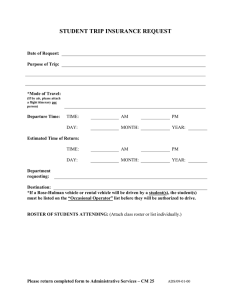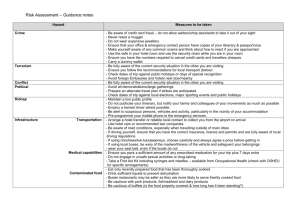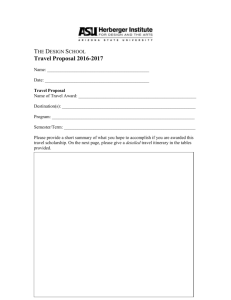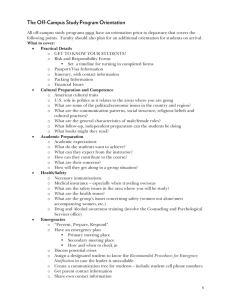Group Trip Planning Checklist and Travel Documentation Group leader name: Program/destination:
advertisement
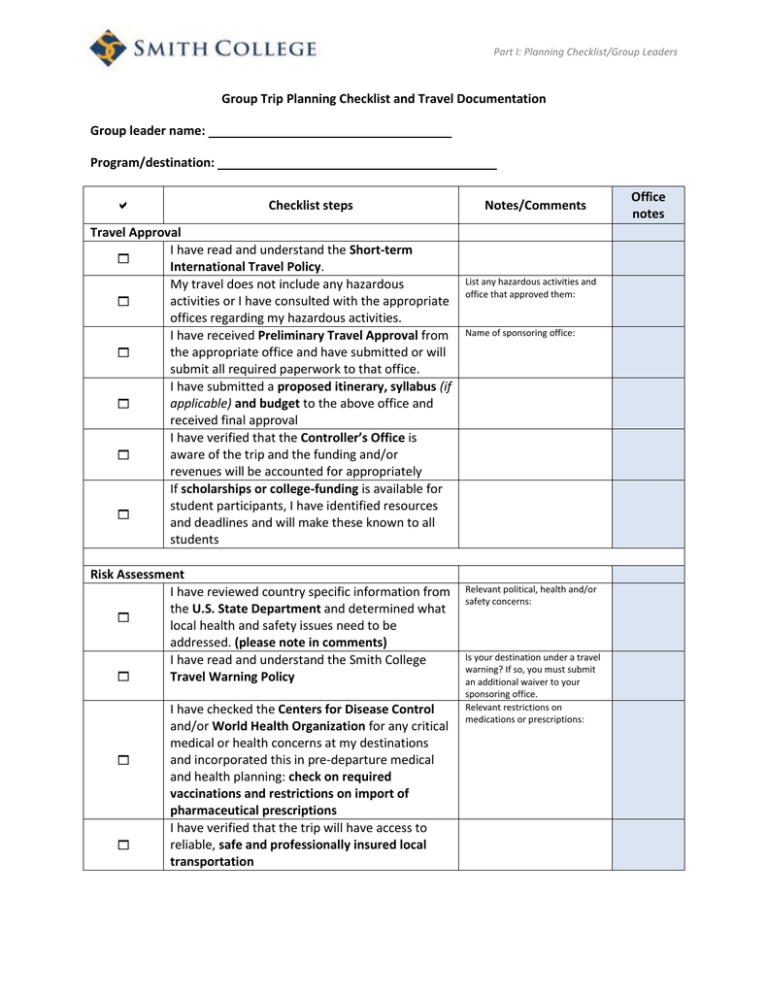
Part I: Planning Checklist/Group Leaders Group Trip Planning Checklist and Travel Documentation Group leader name: Program/destination: Checklist steps Travel Approval I have read and understand the Short-term International Travel Policy. My travel does not include any hazardous activities or I have consulted with the appropriate offices regarding my hazardous activities. I have received Preliminary Travel Approval from the appropriate office and have submitted or will submit all required paperwork to that office. I have submitted a proposed itinerary, syllabus (if applicable) and budget to the above office and received final approval I have verified that the Controller’s Office is aware of the trip and the funding and/or revenues will be accounted for appropriately If scholarships or college-funding is available for student participants, I have identified resources and deadlines and will make these known to all students Risk Assessment I have reviewed country specific information from the U.S. State Department and determined what local health and safety issues need to be addressed. (please note in comments) I have read and understand the Smith College Travel Warning Policy I have checked the Centers for Disease Control and/or World Health Organization for any critical medical or health concerns at my destinations and incorporated this in pre-departure medical and health planning: check on required vaccinations and restrictions on import of pharmaceutical prescriptions I have verified that the trip will have access to reliable, safe and professionally insured local transportation Notes/Comments List any hazardous activities and office that approved them: Name of sponsoring office: Relevant political, health and/or safety concerns: Is your destination under a travel warning? If so, you must submit an additional waiver to your sponsoring office. Relevant restrictions on medications or prescriptions: Office notes Part I: Planning Checklist/Group Leaders I have identified the name and address of local hospitals for emergencies and am familiar with the Smith College AIG/Travel Guard emergency response insurance plan Pre-departure orientation Review goals and purpose of the trip Orient students to key political, cultural and geographic features of destination Provide overview of health and safety concerns, including crime and harassment based on gender, ethnicity or other characteristics Develop group dynamic expectations and guidelines, including conditions for involuntary withdrawal Review packing guidelines, passport & visa status, and deadlines for payment or other paperwork Ensure participants have signed Travel Waivers; registered with US Embassy (STEP program) If medical clearance is required, review medical forms; and discuss serious health concerns in confidential meeting with individual students Attached forms completed and registered with the Lewis Global Studies Center (global@smith.edu) Itinerary, with dates, transportation and accommodations Group Roster Emergency Response and Crisis Plan Provide this information in Part IV, Section 3 below. Part II: Itinerary/Group Leaders Program Itinerary Name of program Dates Destination/s Detailed Itinerary (additional info as attachment as needed) Date Location Transportation mode/details Accommodations: Hotel name: Contact info: Hotel name: Contact info: Hotel name: Contact info: Hotel name: Contact info: Hotel name: Contact info: Hotel name: Contact info: Part III: Group Roster Group Roster Full Name (as on passport) Preferred first name Smith 99 # Citizenship Passport # Name Emergency Contact Relationship Phone number/s Part IV: Emergency Response and Crisis Management Plan Emergency Response and Crisis Management Plan Name of program Dates Destination/s 1. Group Leaders’ contact information in-country (cell phone and/or local land-line) Name: Cell or phone #: Name: Cell or phone #: 2. Local Program contact information: Name: Organization: Address: Phone contact (including local country codes): Additional contacts if available: 3. Emergency medical treatment In your primary location, what is the local hospital and/or doctor to visit in an emergency?: Hospital or physician name: Street address: City: Telephone number/s: 4. Communications Establish a crisis communication plan with students and include in your orientation session. Provide each student with emergency contact information. Communication plans might include group emails for text messages, individual cell phones, a telephone tree, buddy system, and laminated wallet size cards. What is your plan?: 5. Transportation If planned transportation is unavailable (for example, due to strike or natural disaster), what alternative transportation modes are available to reach an airport or major city?
